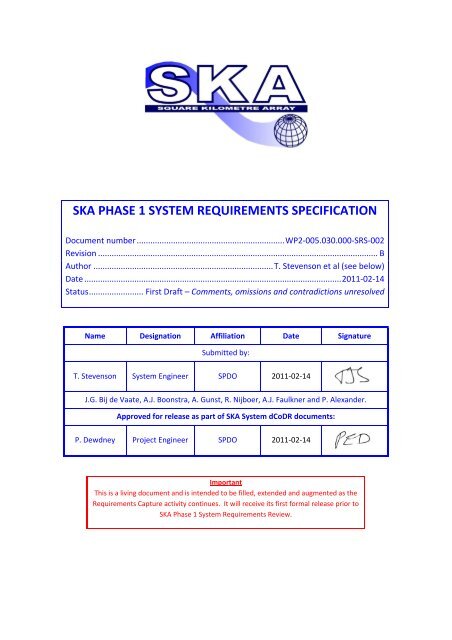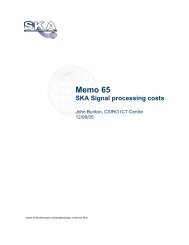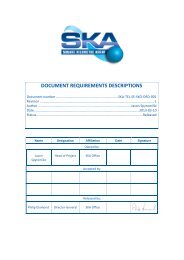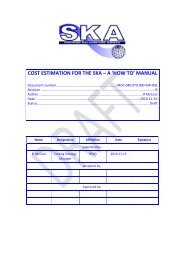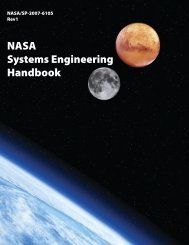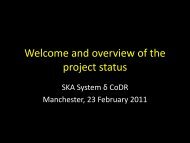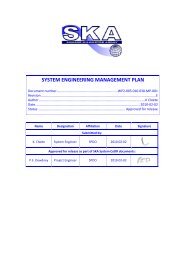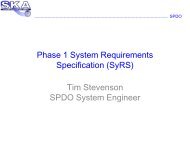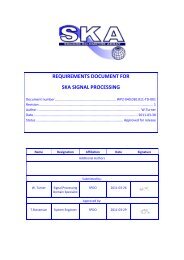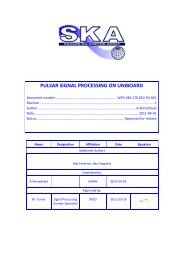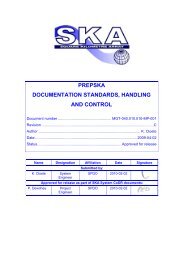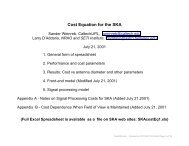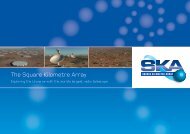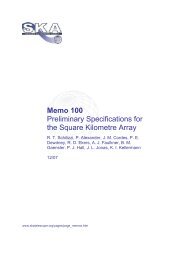ska phase 1 system requirements specification - The Square ...
ska phase 1 system requirements specification - The Square ...
ska phase 1 system requirements specification - The Square ...
- No tags were found...
You also want an ePaper? Increase the reach of your titles
YUMPU automatically turns print PDFs into web optimized ePapers that Google loves.
SKA PHASE 1 SYSTEM REQUIREMENTS SPECIFICATIONDocument number ................................................................. WP2‐005.030.000‐SRS‐002Revision ........................................................................................................................... BAuthor ............................................................................... T. Stevenson et al (see below)Date ................................................................................................................. 2011‐02‐14Status ........................ First Draft – Comments, omissions and contradictions unresolvedName Designation Affiliation Date SignatureSubmitted by:T. Stevenson System Engineer SPDO 2011‐02‐14J.G. Bij de Vaate, A.J. Boonstra, A. Gunst, R. Nijboer, A.J. Faulkner and P. Alexander.Approved for release as part of SKA System dCoDR documents:P. Dewdney Project Engineer SPDO 2011‐02‐14ImportantThis is a living document and is intended to be filled, extended and augmented as theRequirements Capture activity continues. It will receive its first formal release prior toSKA Phase 1 System Requirements Review.
WP2‐005.030.000‐SRS‐002Revision : BDOCUMENT HISTORYRevision Date Of Issue Engineering ChangeNumberCommentsA 2011‐02‐07 ‐ First draft release for internal reviewB 2011‐02‐14 ‐ Updated following reviewDOCUMENT SOFTWAREPackage Version FilenameWordprocessor MSWord Word 2007 WP2‐005.030.000‐SRS‐002‐B_SKA1SysReqSpecORGANISATION DETAILSNamePhysical/PostalAddressSKA Program Development OfficeJodrell Bank Centre for AstrophysicsAlan Turing Building<strong>The</strong> University of ManchesterOxford RoadManchester, UKM13 9PLFax. +44 (0)161 275 4049Website www.<strong>ska</strong>telescope.org2011‐02‐14 Page 2 of 58
WP2‐005.030.000‐SRS‐002Revision : BTABLE OF CONTENTS1 INTRODUCTION ............................................................................................. 71.1 Purpose and scope of the document ...................................................................................... 71.2 Notes on document format..................................................................................................... 72 REFERENCES ................................................................................................. 82.1 Applicable documents ............................................................................................................. 82.2 Reference documents ............................................................................................................. 83 FUNCTIONAL AND PERFORMANCE REQUIREMENTS ................................................. 93.1 Functional Overview ............................................................................................................... 93.2 Science Requirements Derivation ......................................................................................... 113.3 Spectral Characteristics ......................................................................................................... 133.3.1 Operating Frequency ..................................................................................................... 133.3.2 Instantaneous Bandwidth ............................................................................................. 133.3.3 Number, width and placement of station output bands .............................................. 143.3.4 Spectral flatness ............................................................................................................ 143.3.5 Spectral Resolution ....................................................................................................... 153.3.6 Spectral Dynamic Range ................................................................................................ 163.4 SKA 1 Sensitivity and Survey <strong>requirements</strong> ............................................................................ 163.4.1 Sensitivity ...................................................................................................................... 163.4.2 Survey speed ................................................................................................................. 163.4.3 Survey ‘On‐Sky’ time ..................................................................................................... 173.4.4 Deep Field Integration Time .......................................................................................... 173.5 Baseline <strong>requirements</strong> .......................................................................................................... 173.6 Temporal characteristics ....................................................................................................... 183.6.1 Main beam stability ....................................................................................................... 183.6.2 Temporal resolution ...................................................................................................... 183.6.3 Spatial side‐lobe stability .............................................................................................. 183.6.4 Beam‐switching agility .................................................................................................. 183.6.5 Frequency switching agility ........................................................................................... 193.7 Polarisation characteristics ................................................................................................... 193.8 RFI avoidance ........................................................................................................................ 203.9 Imaging characteristics .......................................................................................................... 203.9.1 Instantaneous field of view ........................................................................................... 203.9.2 Imaging dynamic range ................................................................................................. 203.9.3 Pointing accuracy .......................................................................................................... 213.9.4 Pointing estimation accuracy ........................................................................................ 213.10 Monitoring and Control (M&C) Function .............................................................................. 213.10.1 Top‐level <strong>requirements</strong> ................................................................................................. 213.10.2 Control <strong>requirements</strong> .................................................................................................... 243.10.3 Monitoring <strong>requirements</strong> .............................................................................................. 253.11 Data Acquisition Characteristics ........................................................................................... 262011‐02‐14 Page 3 of 58
WP2‐005.030.000‐SRS‐002Revision : B3.12 Observational Modes ............................................................................................................ 263.12.1 Top level modes ............................................................................................................ 263.12.2 Data Products ................................................................................................................ 274 OPERATIONAL REQUIREMENTS ....................................................................... 284.1 General .................................................................................................................................. 284.2 Routine operations ................................................................................................................ 284.3 Start‐up and shutdown ......................................................................................................... 294.4 Failure management ............................................................................................................. 314.4.1 General .......................................................................................................................... 314.4.2 Detection and reporting ................................................................................................ 324.4.3 Diagnosis and recovery ................................................................................................. 334.4.4 Lifetime ......................................................................................................................... 344.5 Maintenance ......................................................................................................................... 354.6 Disposal <strong>phase</strong> ....................................................................................................................... 385 DESIGN CONSTRAINTS .................................................................................. 385.1 Environmental Requirements ............................................................................................... 385.1.1 General .......................................................................................................................... 385.1.2 Site and infrastructure <strong>requirements</strong> ........................................................................... 395.1.3 Contamination and precipitation .................................................................................. 395.1.4 Climatic <strong>requirements</strong> ................................................................................................... 405.1.5 Radio Frequency Interference ....................................................................................... 415.1.6 Electro Magnetic Compatibility ..................................................................................... 415.1.7 Self‐generated RFI environment ................................................................................... 435.1.8 Lightning ........................................................................................................................ 435.1.9 Grounding...................................................................................................................... 435.1.10 Corrosion ....................................................................................................................... 445.1.11 Seismicity ....................................................................................................................... 445.1.12 Other Aspects ................................................................................................................ 445.2 Engineering Design Constraints ............................................................................................ 455.2.1 General .......................................................................................................................... 455.2.2 Size and weight ............................................................................................................. 465.2.3 Materials and Processes ................................................................................................ 465.2.4 Marking ......................................................................................................................... 475.2.5 Power and other utilities ............................................................................................... 485.3 Quality Factors Requirements ............................................................................................... 485.3.1 General .......................................................................................................................... 485.3.2 Workmanship ................................................................................................................ 495.3.3 System Safety ................................................................................................................ 495.3.4 Security .......................................................................................................................... 505.3.5 Reliability ....................................................................................................................... 505.3.6 Maintainability .............................................................................................................. 505.3.7 Flexibility and upgradability .......................................................................................... 515.3.8 Accessibility and testability ........................................................................................... 512011‐02‐14 Page 4 of 58
WP2‐005.030.000‐SRS‐002Revision : B5.3.9 Transportability and storage ......................................................................................... 525.3.10 Life ................................................................................................................................. 536 INTERFACE REQUIREMENTS ............................................................................ 536.1 External Interfaces ................................................................................................................ 536.1.1 Power ............................................................................................................................ 536.1.2 Data synchronization..................................................................................................... 546.2 Internal Interfaces ................................................................................................................. 546.2.1 Power ............................................................................................................................ 546.3 Synchronization ..................................................................................................................... 557 SUPPORT REQUIREMENTS ............................................................................. 557.1 Maintenance ......................................................................................................................... 557.2 Logistics ................................................................................................................................. 558 EXTENSIBILITY REQUIREMENTS ....................................................................... 558.1 Extension interfaces .............................................................................................................. 568.2 Extension performance ......................................................................................................... 569 QUALITY ASSURANCE PROVISIONS................................................................... 579.1 System Qualification testing ................................................................................................. 579.2 Test Methods ........................................................................................................................ 57APPENDIX 1. LIST OF DRM TECHNICAL SPECIFICATIONS .............................................. 58LIST OF FIGURESFigure 1: High level SKA functional context diagram .............................................................................. 9Figure 2: 2nd layer of the SKA functional hierarchy ............................................................................. 10LIST OF TABLESTable 1 : Specification classification of DRM science cases .................................................................. 122011‐02‐14 Page 5 of 58
WP2‐005.030.000‐SRS‐002Revision : BLIST OF ABBREVIATIONSAA .................................. Aperture ArrayAC .................................. Alternating CurrentADC ............................... Analogue to Digital ConverterADD ............................... Architectural design DocumentdB .................................. Decibeldeg ................................. degreeDRM .............................. Design Reference MissionDC ................................. Direct CurrentEM ................................. Electro MagneticEMC ............................... Electro Magnetic CompatibilityFOV ............................... Field of ViewGHz ............................... Giga HertzHz .................................. HertzJy ................................... JanskyK .................................... KelvinKg .................................. kilogramkm .................................. kilometrekVA ................................ kilo Volt AmpereLOFAR........................... Low Frequency Arraym .................................... metreM&C ............................... Monitoring and ControlMHz ............................... Mega HertzPAF ................................ Phased Array FeedRFI ................................. Radio Frequency InterferenceSKA ............................... <strong>Square</strong> Kilometre ArraySKADS .......................... SKA Design StudiesSPDO ............................ SKA Program Development OfficeSRS ............................... System Requirements SpecificationSS .................................. Survey SpeedTBC ............................... To Be ConfirmedTBD. .............................. To Be DeterminedV .................................... Volt2011‐02‐14 Page 6 of 58
WP2‐005.030.000‐SRS‐002Revision : B1 Introduction1.1 Purpose and scope of the documentThis document represents the draft SKA Phase 1 (SKA 1 ) System Requirement Specification and assuch this document aims to:1) Capture the envelope of all aspects that will eventually contribute and feed into the <strong>system</strong><strong>requirements</strong>,2) Provide the source of <strong>requirements</strong> in a <strong>system</strong> requirement <strong>specification</strong> which will flowdown to the lower tiers of the Observatory Hierarchy,This is a living document with applicability throughout all <strong>phase</strong>s of the Project.It is foreseen that these high level <strong>requirements</strong> which have been allocated downwards will beinfluenced as more work at the lower tiers of the Observatory hierarchy is done and the feasibility ofmeeting them is analysed. <strong>The</strong>se influences will be rolled back up to the <strong>system</strong> level and possiblechanges to the <strong>system</strong> <strong>requirements</strong> will be analysed against the higher level <strong>requirements</strong> such asthe science <strong>requirements</strong> in the Design Reference Mission. Trade‐offs will have to be performed toconfirm possible changes and if changes are to be made, these changes will have to be captured androlled back down to the lower levels.During the next <strong>system</strong> engineering <strong>phase</strong>, the Definition Phase, the focus will be to continue togather the <strong>requirements</strong> from all the relevant sources and stakeholders, to analyse and verify these<strong>requirements</strong> and to capture these <strong>requirements</strong> in the <strong>system</strong> <strong>requirements</strong> <strong>specification</strong>. At theend of the <strong>phase</strong> the aim is to have a complete set of stable and traceable <strong>requirements</strong>.<strong>The</strong> <strong>requirements</strong> currently contained in this document are based on V1.3 of the Phase 1 DesignReference Mission (DRM), the Phase 2 DRM (V1.0) (to inform the derivation of extensibility<strong>requirements</strong>) and requirement <strong>specification</strong>s / experience gained from other radio astronomyinstruments such as the Low Frequency Array (LOFAR).1.2 Notes on document formatThis document contains high level, formal <strong>requirements</strong> that must be:QuantifiableJustifiedConfiguration controlledTraceableUnambiguousUniqueSingular2011‐02‐14 Page 7 of 58
WP2‐005.030.000‐SRS‐002Revision : BSelf containedVerifiableAdditionally, and where appropriate (as an aid to verification for instance), requirement numericalvalues have a tolerance within which the requirement is satisfied.Requirements have unique identifier codes which are used in circumstances where reproducing thetext of the requirement is inappropriate. In this document they are of the format SYS_REQ_nnnnwhere SYS signifies System level, REQ signifies a requirement conforming to the above rules andnnnn is a unique numerical identifier.Requirements in this document are of the form:Identifier Requirement text Applicable as Mandatory orTarget (or Redundant ifexceeded elsewhere)Traceable from(parentrequirement) orRationaleVerificationmethod<strong>The</strong> <strong>requirements</strong> that appear in this document will be entered into a database whose purpose is(amongst other things) to provide configuration management and analysis through tracing. Atpresent, this representation of <strong>system</strong> level <strong>requirements</strong> is the ruling document.2 References2.1 Applicable documents<strong>The</strong> following documents are applicable to the extent stated herein. In the event of conflict betweenthe contents of the applicable documents and this SKA1 System Requirement Specification (SRS)document, this document shall take precedence over the applicable documents.[1] SKA Science Working Group, “<strong>The</strong> <strong>Square</strong> Kilometre Array Design Reference Mission: SKAPhase 1”, report, v.1.3, January 2011.[2] SKA Science Working Group, “<strong>The</strong> <strong>Square</strong> Kilometre Array Design reference Mission: SKAmidand SKA‐lo”, report, v.0.4, October 2009.[3] <strong>The</strong> SKA Science and Support Operations Plan WP2‐001.010.010‐PLA‐002[4] T. Stevenson, “SKA System Engineering Management Plan”, document WP2‐005.010.030‐MP‐001, Revision F.[5] K. Cloete et al, “Strategies and Philosophies”, document WP2‐005.010.030‐TR‐001, Rev F,dated 2011‐02‐11.2.2 Reference documents<strong>The</strong> following documents are referenced in this document. In the event of conflict between thecontents of the referenced documents and this document, this document shall take precedence.2011‐02‐14 Page 8 of 58
WP2‐005.030.000‐SRS‐002Revision : B[6] P. Dewdney et al, ‘SKA‐Phase 1: High Level System Description’, documentWP2‐005.030.010‐TD‐002, Rev A, dated 2011‐02‐14.[7] SKA Memo 125: ‘Concept Design for SKA Phase 1 (SKA 1 )’, M.A. Garrett, J.M. Cordes, D. DeBoer, J.L. Jonas, S. Rawlings, and R. T. Schilizzi (SSEC SKA Phase 1 Sub‐committee), 30 May2010.[8] SKA Memo 130: ‘SKA Phase 1: Preliminary System Description’, P.E. Dewdney et al, datedNovember 2010.3 Functional and Performance Requirements3.1 Functional Overview<strong>The</strong> high level functional context diagram for the SKA 1 is shown in Figure 1. From this figure it is clearthat the SKA 1 , and therefore the <strong>system</strong> <strong>requirements</strong>, are influenced by various aspects and interactwith various aspects. A more detailed description of the context and each of the interfaces can befound in [6].Figure 1: High level SKA1 functional context diagram2011‐02‐14 Page 9 of 58
WP2‐005.030.000‐SRS‐002Revision : B<strong>The</strong> next level of the functional hierarchy is detailed in Figure 2. <strong>The</strong> primary functions of the SKA 1are:1) Reception2) Signal Processing3) Computing4) Synchronisation and Timing5) Monitoring and Controlling6) Power generation7) Cooling8) Networking9) ScienceFigure 2: 2nd layer of the SKA 1 functional contextDetailed analysis of all of these functions of the <strong>system</strong> is provided in RD [6]. Each of the functionsand interfaces identified in the figures above will contribute to the <strong>requirements</strong> for the <strong>system</strong>. Notall of them are addressed in this document as yet.2011‐02‐14 Page 10 of 58
WP2‐005.030.000‐SRS‐002Revision : B3.2 Science Requirements Derivation<strong>The</strong> science <strong>requirements</strong> have primarily been extracted from the science cases discussed in theDRM [1] and are listed below. <strong>The</strong> numbers are related to the chapter number of the science cases inthe DRM document.2 Probing the Neutral Intergalactic Medium During the Epoch of Reionization3 Tracking Galaxy Evolution over Cosmic Time via H I Absorption4 Probing the Epoch of Reionization Using the 21‐cm Forest5 Pulsar Surveys6 Pulsar Timing7 Extensibility: Phase 1 to Phase 2<strong>The</strong> SKA1 DRM [1] includes a direct translation of astronomical <strong>requirements</strong> into a limited set of<strong>system</strong> <strong>requirements</strong>. It concerns the following observational and technical <strong>system</strong> <strong>requirements</strong>:Spectral: frequency range (Hz) instantaneous bandwidth (Hz) channel width (Hz) channel width required for RFI avoidance/suppression (Hz)Spatial: minimum or maximum baseline (m) instantaneous FOV (degree 2 ) sky coverage (degree 2 )Temporal time resolution (s)Sensitivity sensitivity (Aeff/Tsys, in m 2 K ‐1 ) survey speed (m 4 K ‐2 deg 2 )Dynamic range imaging dynamic range (dB) spectral dynamic range (dB) polarization dynamic range (dB)Three classes of top level <strong>requirements</strong> can be distinguished, scientific <strong>requirements</strong>, derivedtechnical <strong>requirements</strong> and constraint <strong>requirements</strong>.Scientific <strong>requirements</strong> are directly related to the SKA 1 astronomical science cases, and includefrequency range, polarisation, and limiting flux density. <strong>The</strong>se <strong>requirements</strong> are more or less2011‐02‐14 Page 11 of 58
WP2‐005.030.000‐SRS‐002Revision : Bstraightforwardly derived from the astronomical science cases. As these <strong>requirements</strong> are mutuallyindependent, there are no trade‐offs possible between any of the astronomical <strong>requirements</strong>.Derived technical <strong>requirements</strong> are <strong>requirements</strong> derived from scientific <strong>requirements</strong>, and fromobservational constraints such as time allocation and scheduling. Survey speed and sensitivity, forexample, can only be connected to astronomical <strong>requirements</strong> if the required observation time isspecified. Also, part of the technical <strong>requirements</strong> is mutually dependent. This means that somederived technical <strong>requirements</strong> can be adjusted without compromising the astronomical science<strong>requirements</strong>. Instantaneous bandwidth and survey speed for example can have any value withincertain ranges as long as their product is a specified constant.Constraint <strong>requirements</strong> are those stemming from practical considerations and the consequences ofaccommodating the Observatory in the real world. Examples of these are Regulatory <strong>requirements</strong>and Human Factor Requirements.In the current version of the SRS, there is not yet any strict separation between the astronomical<strong>requirements</strong> and derived technical <strong>requirements</strong>. Such an approach would require, for each sciencecase, a detailed analysis of the dependencies between the two classes of <strong>requirements</strong> in relation tothe operational constraints.In Table 1 science cases are classified in terms of observation mode and main <strong>requirements</strong><strong>specification</strong>s: sensitivity, Field of View (FOV), bandwidth, dynamic range, and baseline. <strong>The</strong>identifier ‘X’ means that there exists a requirement <strong>specification</strong>, ‘‐’ means that there is no explicitrequirement.Science chapters are:2 Probing the Neutral Intergalactic Medium during the Epoch of Reionization3 Tracking Galaxy Evolution over Cosmic Time via H I Absorption4 Probing the Epoch of Re‐ionization using the 21cm Forest5 Pulsar Surveys with Phase 1 of the SKA6 Pulsar Timing with Phase 1 of the SKA7 Additional Telescope Considerations: Phase 1 to Phase 2Table 1 : Specification classification of DRM science chaptersScience chapterParameter234567Frequency Range X X X X X XSurvey Speed ‐ X ‐ ‐ ‐ ‐A e /T sys X ‐ ‐ X X ‐Frequency Resolution X X X X ‐ ‐Temporal Resolution ‐ ‐ ‐ X ‐ ‐Polarisation Purity X ‐ ‐ ‐ X XImaging Dynamic Range ‐ X ‐ ‐ ‐ XSpectral Dynamic Range ‐ X X ‐ ‐ ‐Required Baseline ‐ X ‐ ‐ ‐ ‐2011‐02‐14 Page 12 of 58
WP2‐005.030.000‐SRS‐002Revision : B3.3 Spectral CharacteristicsThis section refers to the part of the spectrum to be observed with SKA 1 . It has an impact on theantenna and receiver <strong>specification</strong>s, but also on the dimensions of all digital processing.3.3.1 Operating FrequencyIdent Requirement Applicability Parent VerificationSYS_REQ_1110Electromagnetic frequencyrange. SKA1 shall be able tomeasure electromagneticradiation in a frequency rangefrom 70 MHz to 3 GHz.3.3.2 Instantaneous BandwidthMandatory [1] Table 8.1 TestIdent Requirement Applicability Parent VerificationSYS_REQ_1120Instantaneous bandwidth. SKA1shall have an instantaneousbandwidth, of:Fractional instantaneousbandwidth: 1 <strong>The</strong> SKA Phase 1shall be designed so that thefractional instantaneousbandwidth is comparable to theobserving frequency.Mandatory[1]Paragraph1.4.3 andTable 2.2TestIdent Requirement Applicability Parent VerificationSYS_REQ_1130Frequency band positioning. Itshall be possible to position thisband anywhere within theoperating frequency band, with apositioning accuracy as specifiedin SYS_REQ_1970 andSYS_REQ_1980. <strong>The</strong>instantaneous observablefrequency band is a contiguous(TBC) band selected from thetotal frequency range.MandatoryTestIdent Requirement Applicability Parent VerificationSYS_REQ_1140Band selection resolution. <strong>The</strong>resolution with which the 500MHz and 1 GHz bands can beselected shall be TBD or less.MandatoryTest2011‐02‐14 Page 13 of 58
WP2‐005.030.000‐SRS‐002Revision : BIdent Requirement Applicability Parent VerificationSYS_REQ_1150Polarization frequency equality. Itshall not be possible to selectdifferent digitized bands for thetwo polarizations of a singledish/antenna/array.MandatoryTest3.3.3 Number, width and placement of station output bandsIdent Requirement Applicability Parent VerificationSYS_REQ_1160Sub‐band bandwidth. <strong>The</strong> subbandbandwidth after stationlevel beamforming shall be lessthan TBD Hz.MandatoryTestIdent Requirement Applicability Parent VerificationSYS_REQ_1170DSP signal processing capacity.<strong>The</strong> digital processing capacityshall be sufficient to process allsub‐bands (Q: and beams, andpolarizations, or should there beexchangeability).MandatoryTestIdent Requirement Applicability Parent VerificationSYS_REQ_1180Beam sub‐band and channel<strong>phase</strong> relations. <strong>The</strong> <strong>phase</strong>relations between the sub‐bandsand channels within a beam shallbe known to such a precision thatwider bands and correspondingtime series can be reconstructedfrom sub‐bands and/or channels.MandatoryAnalysis/Test3.3.4 Spectral flatnessIdent Requirement Applicability Parent VerificationSYS_REQ_1190Spectral baseline. <strong>The</strong> SKA Phase1 shall be designed so that thebandpass does not show ripplesor <strong>system</strong>atic fluctuations, onscales smaller than a frequencycorresponding to about 300 kms −1 , that are larger than twice thethermal noise level after anintegration of 1000 hr.Mandatory [1]Paragraph1.4.4Test2011‐02‐14 Page 14 of 58
3.3.5 Spectral ResolutionWP2‐005.030.000‐SRS‐002Revision : BIdent Requirement Applicability Parent VerificationSYS_REQ_1210Spectral resolution. SKA1 shalloffer a spectral resolution in eachpolarization for scienceprocessing of:< 200 Hz in the band 70 to 240MHz; ‘<strong>The</strong> SKA Phase 1 shallprovide a frequency resolution ofat least 0.2 kHz.’< 10kHz in the band 400MHz to 3GHz100kHz in the band 70 to 240MHz; ‘This requirement followsdirectly from the radial resolutionscience requirement. Forreference, assuming theconcordance cosmology, at theseredshifts, the co‐moving length isgiven by ≈ 1.7 Mpc (/100 kHz).<strong>The</strong>refore, to match the angularresolution a frequency resolutionof about 100 kHz is required.’1 kHz in the band 70 to 240 MHz;‘In practice a more stringentrequirement of 1 kHz in frequencyresolution is required to identifyand excise RFI, reduce bandwidthsmearing, and calibrateionospheric effects.’Mandatory [1]Paragraph4.4.2 andTable 8‐2Mandatory [1]Paragraph5.4, Table 5‐2 and Table8‐2Redundant [1] Table 8‐2andParagraph2.4.2Redundant [1]Paragraph2.4.2TestIdent Requirement Applicability Parent VerificationSYS_REQ_1220Sub‐band and channel <strong>phase</strong>relations. <strong>The</strong> signal processingperformed on each sub‐band shallleave the relative <strong>phase</strong>s of subbandsand spectral channelsintact or predictable.TBD2011‐02‐14 Page 15 of 58
3.3.6 Spectral Dynamic RangeWP2‐005.030.000‐SRS‐002Revision : BIdent Requirement Applicability Parent VerificationSYS_REQ_1230Spectral dynamic range. SKA1shall have a spectral dynamicrange of:≥61 dB in the band 70MHz to 240MHz≥43 dB in the band 200 MHz to1.4 GHzMandatory [1]Paragraph4.4.3 andTables 8‐1and 8‐2Mandatory [1]Paragraph3.4.3 andTable 8‐2TestTest3.4 SKA 1 Sensitivity and Survey <strong>requirements</strong>3.4.1 SensitivityIdent Requirement Applicability Parent VerificationSYS_REQ_1310 Sensitivity (A eff /T sys ). <strong>The</strong> SKA 1shall have a sensitivity of:10 3 m 2 K ‐1 in the frequency range70 MHz ‐ 240 MHz10 3 m 2 K ‐1 in the frequency range400 MHz ‐ 3 GHz10 5 m 2 K ‐1 in the frequency range800 MHz ‐ 3 GHzMandatory [1][1] Table 8‐2[1] Table 8‐2[1] Table 8‐23.4.2 Survey speedIdent Requirement Applicability Parent VerificationSYS_REQ_1410Survey speed. <strong>The</strong> SKA 1 surveyspeed requirement is:~10 7 m 4 K ‐2 deg 2 for the frequency Mandatory [1] Table 3‐2range 200MHz to 1.4 GHz>10 7 m 4 K ‐2 deg 2 Mandatory [1]Paragraph3.4.4 & Table8‐12011‐02‐14 Page 16 of 58
WP2‐005.030.000‐SRS‐002Revision : B3.4.3 Survey ‘On‐Sky’ timeIdent Requirement Applicability Parent VerificationSYS_REQ_1420<strong>The</strong> SKA Phase 1 shall be designedso that a major survey can becompleted in 2 years of “on‐sky”observation time.[1]Paragraph1.4.1Analysis3.4.4 Deep Field Integration TimeIdent Requirement Applicability Parent VerificationSYS_REQ_1430<strong>The</strong> SKA Phase 1 shall be designedso that a deep field can becompleted in 1000 hr ofintegration time.Mandatory [1]Paragraph1.4.2Analysis3.5 Baseline <strong>requirements</strong>Ident Requirement Applicability Parent VerificationSYS_REQ_1510Baseline. <strong>The</strong> SKA 1 minimumbaseline requirement is:200 km for the range 70 to 240MHzMandatory [1] Table 2.2Para 2.4.3To be added:‐Instantaneous imaging capability‐Required UV coverage in synthesis mode. How much time you require to fill in the full UV plane‐Sensitivity <strong>requirements</strong> as a function of elevation. Say 50% sensitivity for elevations down to xdegrees‐Subarray <strong>requirements</strong>‐Latency <strong>requirements</strong>‐Minimal frequency resolution required‐Linearity <strong>requirements</strong>‐Passband <strong>phase</strong> stability‐Required clock/timing accuracy2011‐02‐14 Page 17 of 58
WP2‐005.030.000‐SRS‐002Revision : B3.6 Temporal characteristics3.6.1 Main beam stabilityIdent Requirement Applicability Parent VerificationSYS_REQ_16103.6.2 Temporal resolutionMain beam stability. <strong>The</strong>magnitude and <strong>phase</strong> variationsof any SKA1 compound beamover a 12 hours period at anypoint of its half‐power contourshall be less than 1% (TBC)relative to the beam peak.Ident Requirement Applicability Parent VerificationSYS_REQ_1620Temporal resolution. <strong>The</strong> SKAPhase 1 shall have an attainabletime resolution of at least as shortas 50 μs.Temporal resolution shall be 100μs3.6.3 Spatial side‐lobe stabilityTBD[1]Paragraph5.4.4Test[1] Table 8‐1 TestIdent Requirement Applicability Parent VerificationSYS_REQ_16303.6.4 Beam‐switching agilitySpatial side‐lobe stability. Spatialside lobes should be stable towithin TBD.Ident Requirement Applicability Parent VerificationSYS_REQ_1640Beam former weight update rate.Changing the beam formerweights shall be possible every 60seconds (TBC) in the case ofscheduled switching sequences.TBDTBDIdent Requirement Applicability Parent VerificationSYS_REQ_1650Beam former weight ad‐hocupdate response time. Changingthe beam former weights shall bepossible within 60 seconds in caseof changes due to manualinteraction or changes inschedule.TBD2011‐02‐14 Page 18 of 58
WP2‐005.030.000‐SRS‐002Revision : BIdent Requirement Applicability Parent VerificationSYS_REQ_1660Beam‐switching downtimeflagging. Observation data(specify: both uv(w)‐data and tiedarray beams) acquired during achange of beam direction shall beflagged.TBD3.6.5 Frequency switching agilityIdent Requirement Applicability Parent VerificationSYS_REQ_1670<strong>The</strong> SKA shall be able to ‘switchbetween observing frequencieswithin 10 minutes or less’ (in theband 0.8–3 GHz)‘near simultaneous access tomultiple frequencies’Mandatory [1]Paragraph6.4.4 andTable 6‐2[1] Table 8‐1Test3.7 Polarisation characteristicsIdent Requirement Applicability Parent VerificationSYS_REQ_1710Beam polarization stability. <strong>The</strong>polarization properties of thebeams shall be stable enough toallow their calibration to betterthan 0.5% (TBC)Ident Requirement Applicability Parent VerificationSYS_REQ_1720External calibrationmeasurements shall be necessaryat a rate of no more than onceper hour (TBC).TBDIdent Requirement Applicability Parent VerificationSYS_REQ_1730Stokes parameters. SKA1 shallprovide visibility data in all fourStokes parameters.TBDIdent Requirement Applicability Parent VerificationSYS_REQ_1740Instrumental polarisation. <strong>The</strong>polarisation introduced by theinstrument, after calibration, shallbe less than 0.5% of the totalintensity. (TBC)TBD2011‐02‐14 Page 19 of 58
3.8 RFI avoidanceWP2‐005.030.000‐SRS‐002Revision : BIdent Requirement Applicability Parent VerificationSYS_REQ_1810<strong>The</strong> SKA 1 shall have limited (TBD)susceptibility to bursty/spiky RFI(for pulsars, transients)TBDIdent Requirement Applicability Parent VerificationSYS_REQ_1820Note: Section to be expanded.3.9 Imaging characteristicsTransient RFI detection. <strong>The</strong> poststation level processing shalldetect and flag invalid data.3.9.1 Instantaneous field of viewIdent Requirement Applicability Parent VerificationSYS_REQ_1910Instantaneous field of view‘<strong>The</strong>se <strong>requirements</strong> imply a fieldof view greater than 5 degrees.’TBD[1]Paragraph2.3.5Ident Requirement Applicability Parent VerificationSYS_REQ_1920Field of view imaging. It shall bepossible to image the entire fieldof viewTBD3.9.2 Imaging dynamic rangeIdent Requirement Applicability Parent VerificationSYS_REQ_1940 Imaging dynamic range. SKA 1shall be able to provide animaging dynamic range forcontinuum imaging (thermalnoise imaging to classical (microJansky (Jy)) confusion limits) of atleast:35dB for the band 200MHz‐1.4GHz‘studies ofstar formation at high redshiftwith a continuum deep fieldrequire a dynamic range of 74 dBin imaging’Mandatory [1] Table 8‐2[1]Paragraph7.4 andTable 8‐22011‐02‐14 Page 20 of 58
WP2‐005.030.000‐SRS‐002Revision : B3.9.3 Pointing accuracy<strong>The</strong> mechanical and electronic pointing accuracy <strong>requirements</strong> of the dishes and the AAs are listedbelow.Ident Requirement Applicability Parent VerificationSYS_REQ_1950Dish beam absolute pointingaccuracy. <strong>The</strong> pointing accuracyof the dish beams is: TBDTBDIdent Requirement Applicability Parent VerificationSYS_REQ_1960AA beam absolute pointingaccuracy. <strong>The</strong> pointing accuracyof the AA beams is: TBDTBD3.9.4 Pointing estimation accuracy<strong>The</strong> mechanical and electronic pointing estimation accuracy <strong>requirements</strong> of the dishes and the AAs,are listed below.Ident Requirement Applicability Parent VerificationSYS_REQ_1970Dish beam pointing estimationaccuracy. <strong>The</strong> pointing estimationaccuracy of the dish beams is:TBDTBDIdent Requirement Applicability Parent VerificationSYS_REQ_1980AA beam pointing estimationaccuracy. <strong>The</strong> pointing estimationaccuracy of the AA beams is: TBDTBD3.10 Monitoring and Control (M&C) FunctionMonitoring And Control is a central <strong>system</strong> responsible for acquiring monitoring data and for controlof the SKA1 <strong>system</strong>s. It has a level of autonomy and its sub‐<strong>system</strong>s are distributed to local areas.3.10.1 Top‐level <strong>requirements</strong>Ident Requirement Applicability Parent VerificationSYS_REQ_2110M&C. SKA 1 shall provide amonitoring and control function.TBD2011‐02‐14 Page 21 of 58
WP2‐005.030.000‐SRS‐002Revision : BIdent Requirement Applicability Parent VerificationSYS_REQ_2120M&C purpose. <strong>The</strong> monitoringand control function shall ensurethat all parts of the <strong>system</strong> worktogether coherently. All controlfunctions, except certain localmaintenance functions, are partof the M&C <strong>system</strong>.TBDIdent Requirement Applicability Parent VerificationSYS_REQ_2130M&C failure detection. <strong>The</strong>monitoring and control functionshall ensure that failures inhardware, software or signaltransport are detected andreported.TBDIdent Requirement Applicability Parent VerificationSYS_REQ_2140M&C autonomy. <strong>The</strong> monitoringand control function shall takeautonomous action to amelioratefailures where possible andsupport a fail‐safe philosophy.TBDIdent Requirement Applicability Parent VerificationSYS_REQ_2150M&C shall take autonomousaction in safety critical situationssuch as <strong>system</strong> power failure,over‐temperature, and storms(dish‐stowing).TBDIdent Requirement Applicability Parent VerificationSYS_REQ_2160M&C transparency. <strong>The</strong>monitoring and control functionshall give user transparent andhierarchical access to theinstruments functions andparameters.TBDIdent Requirement Applicability Parent VerificationSYS_REQ_2190M&C remote operation. <strong>The</strong>monitoring and control functionshall be designed to operate theinstrument fully remotely.TBD2011‐02‐14 Page 22 of 58
WP2‐005.030.000‐SRS‐002Revision : BIdent Requirement Applicability Parent VerificationSYS_REQ_2210M&C performance monitoring.<strong>The</strong> monitoring and controlfunction shall provide TBDperformance monitoring data tousers.TBDIdent Requirement Applicability Parent VerificationSYS_REQ_2220M&C monitoring data. All SKA1sub<strong>system</strong>s shall providemonitoring data to themonitoring and control function(for performance monitoring andclosed‐loop control functions)TBDIdent Requirement Applicability Parent VerificationSYS_REQ_2230M&C logging. <strong>The</strong> monitoring andcontrol function shall provide fora long‐term logging sub‐functionwith workflow support for theOperational Team and withsufficient information to relate<strong>system</strong> events to artefacts in thedata.TBDIdent Requirement Applicability Parent VerificationSYS_REQ_2240M&C observation interrupt. Itshall be possible to abort anobservation if monitorparameters exceed user specifiedlimits (including RFI mitigationperformance indicationparameters).TBDIdent Requirement Applicability Parent VerificationSYS_REQ_2250M&C calibration information.Individual element calibrationinformation shall be available tothe measurement function.TBD<strong>The</strong> <strong>requirements</strong> on the M&C function related to Health and Safety still needs to be analysed,verified and added.2011‐02‐14 Page 23 of 58
WP2‐005.030.000‐SRS‐002Revision : B3.10.2 Control <strong>requirements</strong>Requirements regarding control of the instrument (configuration of beam forming, correlation etc)Ident Requirement Applicability Parent VerificationSYS_REQ_2310Control <strong>system</strong>. SKA1 shall have acontrol <strong>system</strong> that activelycontrols all <strong>system</strong> settings in theinstrument.TBDIdent Requirement Applicability Parent VerificationSYS_REQ_2320Control <strong>system</strong> autonomy. <strong>The</strong>control <strong>system</strong> shall be capable ofautonomously calculating <strong>system</strong>settings in response to changes ininstrument status, environmentor measurement results.TBDIdent Requirement Applicability Parent VerificationSYS_REQ_2330System settings activation. Itshall be possible to activate thecalculated <strong>system</strong> settings eitherautomatically (autonomouscontrol) or after explicitconfirmation by the operator(manual control).TBDIdent Requirement Applicability Parent VerificationSYS_REQ_2340System setting activationautonomy. It shall be possible tospecify when settings should beactivated automatically and whenthey need to be confirmed by theoperator.TBDIdent Requirement Applicability Parent VerificationSYS_REQ_2350Schedule update. It shall bepossible to receive and acceptupdated schedules before theend‐time of the currently activeschedule has expired.TBD2011‐02‐14 Page 24 of 58
3.10.3 Monitoring <strong>requirements</strong>WP2‐005.030.000‐SRS‐002Revision : BRequirements regarding monitoring the status of the instrument (configuration and health)Ident Requirement Applicability Parent VerificationSYS_REQ_2410Monitoring data consolidation. Itshall be possible to consolidatemonitoring information toproduce high‐level monitoringinformation from low‐levelmonitoring information.TBDIdent Requirement Applicability Parent VerificationSYS_REQ_2420Sub<strong>system</strong>‐M&C action reports.Sub<strong>system</strong>s shall reportcompletion of actions to M&CTBDIdent Requirement Applicability Parent VerificationSYS_REQ_2430M&C summary reports. It shall bepossible for all user roles(<strong>specification</strong> of these roles TBD)to produce summarized historicalmonitoring information.TBDIdent Requirement Applicability Parent VerificationSYS_REQ_2440Control data augmentation. <strong>The</strong>results of control actions shall beverified with measurements madeexpressly for the purpose.If the normal measurementsequence does not provide forcontrol verification in a timelyfashion, such measurements shallbe made out of sequence.TBDIdent Requirement Applicability Parent VerificationSYS_REQ_2450Monitoring informationconsolidation. It shall be possibleto consolidate monitoringinformation both on the physicalinstrument status and ondesignated logical concepts likeobservation, correlator.TBD2011‐02‐14 Page 25 of 58
WP2‐005.030.000‐SRS‐002Revision : B3.11 Data Acquisition CharacteristicsThis section describes the functions in the acquisition and initial processing path. This includes thedefinition of observation modes (synthesis imaging, tied array, fly’s eye, pulsar detection) and ofintermediate and final data products. Also the functional and performance <strong>requirements</strong> for RFImitigation, the data transport network and some derived performance parameters for data handlingare listed here.Note: Section to be expanded.3.12 Observational ModesThis section identifies the top‐level observational modes.3.12.1 Top level modesIdent Requirement Applicability Parent VerificationSYS_REQ_2710Synthesis imaging mode. SKA1shall provide a synthesis imagingmode where compound beamsare correlated to form visibilities.TBDIdent Requirement Applicability Parent VerificationSYS_REQ_2720Visibilities. In synthesis imagingmode it shall be possible to formvisibilities between allcorresponding monochromaticcompound beams (samefrequency, same direction) fromall dishes or all aperture arrays(stations). This means that thecentral processing functionshould be able to handle the fulldata stream from the dishes oraperture arrays in synthesisimaging mode.TBDIdent Requirement Applicability Parent VerificationSYS_REQ_2730Tied array mode. SKA1 shallprovide a tied array mode wherethe signals from all dishes are<strong>phase</strong>d up, after real‐timecorrection of instrumental effects,and transformed back into timeseries for pulsar processing.TBD2011‐02‐14 Page 26 of 58
WP2‐005.030.000‐SRS‐002Revision : BIdent Requirement Applicability Parent VerificationSYS_REQ_2740Fly’s eye mode. SKA1 shallprovide a fly’s eye mode (TBC). Inthis mode the Autocorrelations ofall single dishes / aperture(sub)arrays are recorded. Eachdish / sub‐array is tracking adifferent position on the sky.TBDIdent Requirement Applicability Parent VerificationSYS_REQ_2750Aggregate mode. SKA1 shallprovide an aggregate mode inwhich bandwidth is exchanged forspatial coverage in the correlator.TBDIdent Requirement Applicability Parent VerificationSYS_REQ_2760Real‐time calibration. SKA1 shallprovide instrumental real‐timecalibration functions in allobservational modes.TBDIdent Requirement Applicability Parent VerificationSYS_REQ_2770Re‐processing archive data. Itshall be possible to re‐processdata retrieved from archive. Towhich extent this will besupported needs furtherdiscussion.TBD3.12.2 Data ProductsIdent Requirement Applicability Parent VerificationSYS_REQ_2810Automated data products. SKA1shall be able to produce final dataproducts based on automatedand interactive (manual)processing of acquired data.TBDIdent Requirement Applicability Parent VerificationSYS_REQ_2820Data product types. SKA1 shallproduce recordable intermediatedata products, for example pulsarvoltage time series and RFIstatistics.TBD2011‐02‐14 Page 27 of 58
WP2‐005.030.000‐SRS‐002Revision : B4 Operational Requirements4.1 GeneralThis section states general operational <strong>requirements</strong>.Ident Requirement Applicability Parent VerificationSYS_REQ_3110Up‐time. SKA1 shall be aimed tobe operated continuously (7 daysper week 24 hours per day).TBDIdent Requirement Applicability Parent VerificationSYS_REQ_3130Remote M&C from sites. It shallbe possible for the operator tocontrol and monitor the SKA1instrument from the SKA stationsites and core site.TBDIdent Requirement Applicability Parent VerificationSYS_REQ_3140Physical access security. <strong>The</strong><strong>system</strong> shall provide security toprevent unauthorized physicalaccess to facilities and resources.TBDTo be added: security measures for other aspects such as network access, server access, encryptionof M&C messages.4.2 Routine operationsThis section gives <strong>system</strong> level <strong>requirements</strong> for the routine operations of SKA 1 .Ident Requirement Applicability Parent VerificationSYS_REQ_3150Reconfiguration time.Reconfiguration of SKA1 from oneobservational mode to anothershall not take longer than 5minutes (TBC) provided allsoftware applications are presentat their designated location.TBD2011‐02‐14 Page 28 of 58
WP2‐005.030.000‐SRS‐002Revision : B4.3 Start‐up and shutdownThis section gives <strong>system</strong> level <strong>requirements</strong> for SKA 1 start‐up and shutdown, including check‐out atinitialization.Ident Requirement Applicability Parent VerificationSYS_REQ_3160Full remote control. It shall bepossible to control all SKA1functions from the operationalcentre, without requiring physicalaccess to the instrument,including start‐up and shut down.TBDIdent Requirement Applicability Parent VerificationSYS_REQ_3170Start‐up sequence. <strong>The</strong> start‐upof SKA1 functions shall follow apre‐defined sequence taking notlonger than:10 minutes for a hot start (=restart)24 hours for a cold startTBDTo be added: definition of hot and cold start.Ident Requirement Applicability Parent VerificationSYS_REQ_3180Start‐up and shut‐downindividual antenna <strong>system</strong>s. Itshall be possible to start‐up orshutdown individual dishes oraperture arrays withoutdisturbance [TBC] of routineoperations.TBDIdent Requirement Applicability Parent VerificationSYS_REQ_3190Shut‐down sequence. <strong>The</strong>shutdown of SKA1 shall follow apre‐defined sequence taking notlonger than TBD minutes. SKA1shall also have an emergencyshut‐down for wind (stowingdishes), lightning, and electricpower anomalies.TBD2011‐02‐14 Page 29 of 58
WP2‐005.030.000‐SRS‐002Revision : BIdent Requirement Applicability Parent VerificationSYS_REQ_3210Control over start‐up and shutdown.Initialization of shut‐downand start‐up sequences shall berestricted to designated operatorsand engineers. To be defined:security <strong>requirements</strong> ondifferent access levels (e.g.engineering mode).TBDIdent Requirement Applicability Parent VerificationSYS_REQ_3220Start‐up and shut‐downdependencies. Any dependenciesin the start‐up and shutdownsequences shall be automaticallyverified (so they do not dependon operator intervention).TBDIdent Requirement Applicability Parent VerificationSYS_REQ_3230Sub<strong>system</strong> shut‐down. <strong>The</strong>shutdown of pre‐defined parts ofthe SKA1 <strong>system</strong> shall have no(TBC) impact on SKA1 operationsafter appropriate re‐calibrationperformed automatically.TBDIdent Requirement Applicability Parent VerificationSYS_REQ_3240Initial check‐out. SKA1 shall bedesigned to enable an operationalreadiness check, includingredundancies, prior tocommencement of any SKA1operations (initial check‐out).TBDIdent Requirement Applicability Parent VerificationSYS_REQ_3250Operational readiness check. <strong>The</strong>operational readiness check shallnot take longer to complete than5 minutes.TBD2011‐02‐14 Page 30 of 58
WP2‐005.030.000‐SRS‐002Revision : B4.4 Failure management 14.4.1 GeneralGeneral <strong>requirements</strong> regarding failure managementIdent Requirement Applicability Parent VerificationSYS_REQ_3310Personnel safety. As far aspossible, no single failure in theSKA1 shall lead to personnelsafety hazards.TBDIdent Requirement Applicability Parent VerificationSYS_REQ_3320Failure propagation. Failures inone of the SKA1 sub<strong>system</strong>s shallnot lead to failures in othersub<strong>system</strong>s.TBDIdent Requirement Applicability Parent VerificationSYS_REQ_3330Operator command safety. Nosingle operator command shallcause catastrophic, serious, ormajor consequences.TBDIdent Requirement Applicability Parent VerificationSYS_REQ_3340Voltage transients consequences. No voltage‐transients or "cutoff"of electrical power shall leadto catastrophic or seriousconsequences. This includesvoltage transients applied to theinput of the receivers.TBDIdent Requirement Applicability Parent VerificationSYS_REQ_3350Operator command absence. <strong>The</strong>absence of operator commandsshall not cause catastrophic orserious consequences.TBDIdent Requirement Applicability Parent VerificationSYS_REQ_3360Single‐point failures. Single‐pointfailuresin the design shall be listed.TBD1 Section still to be aligned with Logistic Engineering Management Plan.2011‐02‐14 Page 31 of 58
WP2‐005.030.000‐SRS‐002Revision : BIdent Requirement Applicability Parent VerificationSYS_REQ_3370Single‐point failure justification.Each‐single‐point failure in thedesign shall be justified, andassessed against alternativedesign(s) where this single‐pointfailurewould not occur.TBDIdent Requirement Applicability Parent VerificationSYS_REQ_3380Single‐point failure watchdog.<strong>The</strong> correct functioning of eachsingle‐point‐failure in the designshall be monitored by a watchdogfunction.TBDIdent Requirement Applicability Parent VerificationSYS_REQ_3410Failing equipment. Failingequipment shall not provide data(TBC). Failing equipment shallindicate the problem if power ison, and the control function shalltake appropriate measures.TBD4.4.2 Detection and reportingRequirements regarding failure detecting equipment and how failures are to be reported includinglevel of detection.Ident Requirement Applicability Parent VerificationSYS_REQ_3520Status report availability time.<strong>The</strong> status report of thefunctioning of a sub<strong>system</strong> shallbe available in 5 seconds.TBDIdent Requirement Applicability Parent VerificationSYS_REQ_3530Status report request. <strong>The</strong> statusreport of a sub<strong>system</strong> shall reflectthe functioning of the sub<strong>system</strong> ator after the operator request hasbeen submitted to the <strong>system</strong>.TBD2011‐02‐14 Page 32 of 58
WP2‐005.030.000‐SRS‐002Revision : BIdent Requirement Applicability Parent VerificationSYS_REQ_3540Status report scope. <strong>The</strong> statusreport shall display the status of afunction, together with the<strong>system</strong> time the status wasdetermined.TBD4.4.3 Diagnosis and recoveryRequirements regarding distinguishing of failures and how failures are to be recovered fromIdent Requirement Applicability Parent VerificationSYS_REQ_3610System interrogation reply. Eachdish or aperture array <strong>system</strong>shall have the capability toanswer to an operatorinterrogation, in case of detectedfailures at the dish, whichantenna chain has failed.TBDIdent Requirement Applicability Parent VerificationSYS_REQ_3620System autonomous and manualcontrol modes. <strong>The</strong> <strong>system</strong> shallhave the capability to beoperated by an operator in anautonomous mode, and in amanual control mode.TBDIdent Requirement Applicability Parent VerificationSYS_REQ_3630Autonomous malfunctioningactions. In the autonomousmode, all malfunctioningequipment and/or stations maybe switched off autonomously,and a message with all details ofthis action shall be brought to theattention of the operator, andrecorded in the <strong>system</strong>s log‐file.TBDIdent Requirement Applicability Parent VerificationSYS_REQ_3640Manual control switch on/off. Inthe manual control mode, theoperator shall have the capabilityto switch on or off all equipmentand/or stations.TBD2011‐02‐14 Page 33 of 58
WP2‐005.030.000‐SRS‐002Revision : BIdent Requirement Applicability Parent VerificationSYS_REQ_3650Operator actions logging.Operator actions shall berecorded in the <strong>system</strong>s log‐file,in such a way that a completepicture of all correct functioningand/or all malfunctioningequipment, together with theiroperational and/or switch offstatuses, can be achieved.TBDIdent Requirement Applicability Parent VerificationSYS_REQ_3660Recovery actions. It shall bepossible to take recovery actionswithout consequences for otherparts of SKA1; the <strong>system</strong> shallminimize impact of recoveryactions.TBDIdent Requirement Applicability Parent VerificationSYS_REQ_3670Autonomous recovery. SKA1 shallbe able to recover autonomouslyin case of failures that areclassified as minor or negligible.TBDIdent Requirement Applicability Parent VerificationSYS_REQ_3680Effect of disabled units. <strong>The</strong> SKA1design shall ensure that disabledunits do not corrupt theremaining <strong>system</strong>.TBD4.4.4 LifetimeOperational lifetime <strong>requirements</strong>, including spare parts and supporting equipmentIdent Requirement Applicability Parent VerificationSYS_REQ_3710Continuous operation period.SKA1 shall be designed for acontinuous operational period of6 month. After this timemaintenance may be necessary,e.g. exchange/cleaning of airconditioningfilters andrefurbishment of cryogenic<strong>system</strong>s.TBD2011‐02‐14 Page 34 of 58
WP2‐005.030.000‐SRS‐002Revision : BIdent Requirement Applicability Parent VerificationSYS_REQ_3720Minimum life time. SKA1 shall bedesigned for a minimum life timeof TBD years, including initialinstallation, testing andcommissioning period.TBDIdent Requirement Applicability Parent VerificationSYS_REQ_3730Availability. <strong>The</strong> averageavailability of SKA1 during theoperational period shall be betterthan 90% (TBC). Availability isdefined here as being availablefor scheduled observations in atleast one of the supportedoperational modes.TBDIdent Requirement Applicability Parent VerificationSYS_REQ_3740Upgradeability SKA 1 shall beupgradable.TBDIdent Requirement Applicability Parent VerificationSYS_REQ_3750Life‐time extension. Large scalemaintenance and/or an upgradeshall give the possibility to reach alife time of 50 years (TBC).TBD4.5 Maintenance 2Requirements regarding maintenance concept, corrective and preventiveIdent Requirement Applicability Parent VerificationSYS_REQ_3810Full fail rate. SKA1 shall bedesigned to fully fail less than twotimes per year (TBC), the numberdetermined as average over itsoperational period.TBDNote: Full failure is defined here as an unscheduled inability to operate in any observational modefor more than two hours due to malfunctioning of one or more sub<strong>system</strong>s. <strong>The</strong> requirement appliesto the period after initial commissioning of the <strong>system</strong> or any upgraded components.2 Section still to be aligned with Logistic Engineering Management Plan.2011‐02‐14 Page 35 of 58
WP2‐005.030.000‐SRS‐002Revision : BIdent Requirement Applicability Parent VerificationSYS_REQ_3820Repair period. <strong>The</strong> maximumperiod of repair once a failure ofSKA1 has been established, shallbe 1 (TBC) week. Here, a failure isdefined as not being able to meetthe scientific <strong>specification</strong>s due to(sub)<strong>system</strong> failure(s).TBDIdent Requirement Applicability Parent VerificationSYS_REQ_3830Non‐availability information. Allusers with scheduledmeasurements during the failureperiod shall be informed of thenon‐availability of the <strong>system</strong>TBDIdent Requirement Applicability Parent VerificationSYS_REQ_3840Data loss due to power outage.All sub<strong>system</strong>s shall not lose morethan 4 hours of acquired orprocessed measurement data(not yet permanently stored) as aresult of an outage in the externalpower supply.TBDIdent Requirement Applicability Parent VerificationSYS_REQ_3850Autonomous restart after poweroutage. All sub<strong>system</strong>s shall havethe capability to restartautonomously and withoutfailures, after an outage inexternal power supply.TBDIdent Requirement Applicability Parent VerificationSYS_REQ_3860System availability after restart.All sub<strong>system</strong>s shall be availablewithin 5 minutes (TBC) afterrestart. (Note – there may besub<strong>system</strong>s such as cryo coolersthat will probably not comply tothe requirement and will need tobe handled differently).TBD2011‐02‐14 Page 36 of 58
WP2‐005.030.000‐SRS‐002Revision : BIdent Requirement Applicability Parent VerificationSYS_REQ_3870Software/firmware reinstallation.Allsoftware/firmware in SKA1 shallallow its re‐installation.TBDIdent Requirement Applicability Parent VerificationSYS_REQ_3880Software/firmware upgrades. Itshall be possible to replace allsoftware/firmware configurationitems in SKA1 through softwareupgrades,initiated by anengineer.TBDIdent Requirement Applicability Parent VerificationSYS_REQ_3890Software code identification.Software configuration items shallprovide unambiguous inputs toallow the maintenance of aconfiguration managementdatabase.TBDIdent Requirement Applicability Parent VerificationSYS_REQ_3910Software code identificationresponse time. <strong>The</strong> softwareidentification shall be available tothe operator within 10 seconds(TBC) after the request was made.TBDIdent Requirement Applicability Parent VerificationSYS_REQ_3920Sub<strong>system</strong> maintenancefunctions. All sub<strong>system</strong>s shallinclude functions that allowmaintenance of hardware andsoftware.TBD2011‐02‐14 Page 37 of 58
WP2‐005.030.000‐SRS‐002Revision : B4.6 Disposal <strong>phase</strong>Requirements regarding used materials, ecological aspects, programmatic reserve.Ident Requirement Applicability Parent VerificationSYS_REQ_4110Environmental rule compliancy.<strong>The</strong> SKA1 design shall be fullycompliant to all environmentalrules applicable to the SKA site.TBDIdent Requirement Applicability Parent VerificationSYS_REQ_4120Lasting environmental effects.SKA1 shall be designed to have nolasting adverse environmentaleffects on the facility and site.TBD5 Design constraintsThis chapter specifies the design constraining <strong>requirements</strong> such as determined by the environmentthe instrument will be placed in or relating to mechanical and electrical guidelines, productassurance, safety hazards, government regulations etc. Some <strong>requirements</strong> provided in this chapterwhich appear to be only applicable at sub<strong>system</strong> level may be moved to the "supporting<strong>specification</strong>s" as these are established.5.1 Environmental Requirements5.1.1 GeneralGeneral environmental <strong>requirements</strong>Ident Requirement Applicability Parent VerificationSYS_REQ_5110Climatic and environmentalconditions. SKA1 shall bedesigned or protected against anydeterioration leading to failure tomeet the <strong>requirements</strong> specifiedherein caused by climatic andenvironmental conditions duringits complete lifetime (bothoperating and non‐operating).TBDIdent Requirement Applicability Parent VerificationSYS_REQ_5120Compliancy with localenvironment. <strong>The</strong> design of SKA1shall be appropriate (TBD) foroperation in the naturalenvironment for the geographicaldeployment location of the SKA1.2011‐02‐14 Page 38 of 58TBD
WP2‐005.030.000‐SRS‐002Revision : BIdent Requirement Applicability Parent VerificationSYS_REQ_5130Transportation conditions. SKA1equipment shall be designed forthe induced transportationenvironment appropriate to themode of transport being used(road, air, sea, etc.) betweenplace of manufacturing and finalinstallation on the SKA site (to beincluded: packaging<strong>requirements</strong>).TBD5.1.2 Site and infrastructure <strong>requirements</strong>General <strong>requirements</strong> for station sites, building locations, connecting roadsIdent Requirement Applicability Parent VerificationSYS_REQ_5210Building climate conditioning.Buildings or parts of buildingscontaining central processingequipment and operator areasshall have a climatic conditioning<strong>system</strong> which can control thetemperature within the range of18 ºC to 23 ºC and the humiditywithin the range of 50 % to 70 %independent of weatherconditions.TBDIdent Requirement Applicability Parent VerificationSYS_REQ_5220Facilities and equipmentintrusion. SKA1 equipment andoperating facilities shall beadequately protected againstintrusion by unauthorized personsor by “larger” wandering animals.TBD5.1.3 Contamination and precipitationIdent Requirement Applicability Parent VerificationSYS_REQ_5230Precipitation. SKA1 equipmentshall be able to operate withoutdegradation of the performanceduring any type of precipitation(to be specified).TBD2011‐02‐14 Page 39 of 58
WP2‐005.030.000‐SRS‐002Revision : BIdent Requirement Applicability Parent VerificationSYS_REQ_5240Pollution and contaminationprotection. SKA1 equipment shallbe adequately protected againstperformance degradation causedby contaminating particles (dust,sand etc), polluted air or anyprecipitation.TBD5.1.4 Climatic <strong>requirements</strong>Ident Requirement Applicability Parent VerificationSYS_REQ_5310Humidity. SKA 1 equipmentlocated at the dishes or aperturearrays or outside the centralprocessing and operating facilitiesshall be able to withstandmoisture and humidity levels upto 100 % RH.TBDIdent Requirement Applicability Parent VerificationSYS_REQ_5320Allowable air temperature range.SKA1 equipment located at thedishes or aperture arrays oroutside the central processingand operating facilities shall beable to withstand (non‐operatingif necessary) an outside airtemperature within the range of ‐15 ºC (TBC) to +60 ºC (TBC).TBDIdent Requirement Applicability Parent VerificationSYS_REQ_5330Air temperature operation range.SKA1 equipment located at thedishes or aperture arrays oroutside the central processingand operating facilities shall beable to operate within<strong>specification</strong> if the outside airtemperature is within the rangeof ‐5 ºC (TBC) to +50 ºC (TBC).TBD2011‐02‐14 Page 40 of 58
WP2‐005.030.000‐SRS‐002Revision : BIdent Requirement Applicability Parent VerificationSYS_REQ_5340Wind velocities. SKA1 equipmentshall be able to survive windvelocities up to 160 km/hr (TBC),and shall operate within normal<strong>specification</strong> ranges for windvelocities up to 40 km/hr (TBC).TBD5.1.5 Radio Frequency InterferenceProtection and measures against interfering signals from outside the instrumentIdent Requirement Applicability Parent VerificationSYS_REQ_5410Damaging interference levels.SKA1 shall not be damaged by RFIsignals less than TBD V/m.TBDIdent Requirement Applicability Parent VerificationSYS_REQ_5420EM immunity. SKA1 shall not besusceptible to RFI signals, in‐bandor out‐band, other than via thereceptors.TBDIdent Requirement Applicability Parent VerificationSYS_REQ_5430ADC clipping. <strong>The</strong> dynamic rangeof the ADC’s in the SKA1 shall besuch that no clipping will occur.Clipping occurs when the range ofthe input signal voltages to theADC is larger than the ADCvoltage range. <strong>The</strong> number ofADC bits shall therefore besufficient to prevent clipping dueto strong interfering signals suchas aircraft Distance MeasuringEquipment (DME) and satellitesignals.TBD5.1.6 Electro Magnetic CompatibilityDuring each <strong>phase</strong> of the SKA1 life, from equipment integration until its end of life, the instrumentshall neither cause disturbance to other <strong>system</strong>s, nor suffer loss of performance due to other<strong>system</strong>s or to the RFI environment.2011‐02‐14 Page 41 of 58
WP2‐005.030.000‐SRS‐002Revision : B<strong>The</strong> ability of the SKA1 to perform its mission within the required performance shall bedemonstrated by tests, analysis, inspection, verification of records or demonstration according tothe <strong>system</strong> verification <strong>requirements</strong>.Ident Requirement Applicability Parent VerificationSYS_REQ_5610EMC safety margin. <strong>The</strong> EMCsafety margin, which is defined asthe ratio between susceptibilitythreshold and the interference atany point within the <strong>system</strong>, shallbe greater than TBD dB.TBDIdent Requirement Applicability Parent VerificationSYS_REQ_5620EMC compatibility marking. All"off‐the‐shelf" equipment appliedwithin SKA1 shall posses as aminimum the host country EMCmarking, including electrical andelectronic supporting andinfrastructural equipment.TBDIdent Requirement Applicability Parent VerificationSYS_REQ_5630Grounding concept. A hybridgrounding concept as shown infigures TBD shall be used for EMCpurposes. Ground loops involvingDC, and low frequency AC,currents shall be avoided insidethe <strong>system</strong>. Intentional currentsthrough structure are notpermitted. (to be elaborated)TBDIdent Requirement Applicability Parent VerificationSYS_REQ_5640EMC design efforts. Maximumeffort (to be detailed) shall be putinto designing signal interfaces towithstand noisy environmentsand to minimize the generation ofexcessive noise.TBDEmission <strong>requirements</strong> and tests. Emission <strong>requirements</strong>, both conducted and radiated) and tests(to be elaborated)Susceptibility <strong>requirements</strong> and tests. Susceptibility <strong>requirements</strong> and tests (to be elaborated)2011‐02‐14 Page 42 of 58
WP2‐005.030.000‐SRS‐002Revision : B5.1.7 Self‐generated RFI environmentIdent Requirement Applicability Parent VerificationSYS_REQ_2910Self‐generated RFI susceptibility.Interference due to selfgeneratedRFI shall not degradethe performance of theinstrument by greater than 1% byany measure (TBC).TBD5.1.8 LightningIdent Requirement Applicability Parent VerificationSYS_REQ_5710Lightning dischargesusceptibility. <strong>The</strong> SKA 1 shall beable to withstand theelectromagnetic field impactdefined in TBD during operationor in any other mode without anydamage or characteristicsdegradation because of alightning discharge.TBDIdent Requirement Applicability Parent VerificationSYS_REQ_5720Lightning protection. SKA1dedicated buildings andequipment located on sites shallbe protected to minimize theeffects of a direct lightning strikeusing certified methods (e.g. asdescribed in NEN 1014).TBDIdent Requirement Applicability Parent VerificationSYS_REQ_5730Lightning discharge flagging.Observation data taken during alightning strike shall be flagged.TBDDirect strikes. TBC5.1.9 GroundingRequirements regarding grounding of equipment, personnel safety and instrument performance(electrical grounding concept), use of design standards2011‐02‐14 Page 43 of 58
WP2‐005.030.000‐SRS‐002Revision : BIdent Requirement Applicability Parent VerificationSYS_REQ_5810Safety ground. Electrical safetyground shall be designedaccording to the regulationsimposed by the local government.TBD5.1.10 CorrosionIdent Requirement Applicability Parent VerificationSYS_REQ_5820Corrosion protection. SKA1equipment and buildings shall beprotected against corrosion.TBDIdent Requirement Applicability Parent VerificationSYS_REQ_5830Corrosion protection in air flows.SKA1 electronics and connectorsin areas with a higher air flow (forcooling) or outdoor environmentshall be additionally protectedagainst corrosion.TBD5.1.11 SeismicityIdent Requirement Applicability Parent VerificationSYS_REQ_5910Earthquakes. SKA1 equipmentand buildings shall be protectedagainst earthquakes with amagnitude up to Richter 3.8(TBC).TBD5.1.12 Other AspectsAdditional aspects that will need consideration in this chapter include:Temperature and humidityo Operational• External/exposed equipment• Internal equipment• Human accessible and work areaso Non operational (storage and transportation)Exposure to raino Operational with full performanceo SurvivalHailo SurvivalIce and snow (TBC)Lightning2011‐02‐14 Page 44 of 58
WP2‐005.030.000‐SRS‐002Revision : Bo Direct strikeo Nearby strikeWindo Operationalo SurvivalPressureo Operationalo Survival (air transport)Solar radiation (over and above the ambient temperature)Ingress protection (IP rating) of equipment is different areas (exposed, indoors, etc)Dust and sando Exposed equipment against dust stormso Dust ingress into equipment and buildings especially fibre opticso Electrically charged dustSalt laden atmosphereo Outlying stations close to coastal environmentsVibrationo Operationalo Non operational (transportation of equipment)Shocko Operationalo Non operational (transport of equipment)o Non operational (handling)Solventso Cleaning of equipmentFauna and florao Fungal growtho AnimalsSevere weathero Floodso Severe raino High windso Hail5.2 Engineering Design Constraints5.2.1 GeneralIdent Requirement Applicability Parent VerificationSYS_REQ_6110 Deployment locations. <strong>The</strong> SKA 1shall be installed at the SKA coresite and at the SKA1 station sites.TBDFixed antenna locations. SKA1 will not have movable antenna receptors for the purpose of changingbaseline length. <strong>The</strong> uv(w) coverage is fixed.2011‐02‐14 Page 45 of 58
5.2.2 Size and weightWP2‐005.030.000‐SRS‐002Revision : B<strong>The</strong> front‐end is defined as all equipment that is installed in the feedbox. <strong>The</strong> weight of this is TBD.Ident Requirement Applicability Parent VerificationSYS_REQ_6210Feed Payload volume. <strong>The</strong> SKA1front‐end and cabling shall fit inthe available feedboxes.Ident Requirement Applicability Parent VerificationSYS_REQ_6220, Feed payload mass limit. <strong>The</strong>total mass of any feed payload,including the RF cables to theground, shall not exceed: TBD.TBDTBDNote: this section needs to be expanded.5.2.3 Materials and ProcessesUse is to be made of adequate and (ecological) allowed permissible materials, deviations to beapproved by the project, including management of applied materials.Ident Requirement Applicability Parent VerificationSYS_REQ_7110Materials, Parts and Processeslists. Each sub<strong>system</strong> suppliershall establish, collect, review anddeliver the Materials, Parts andProcesses lists including all theMaterials, Parts and Processesintended for use in the SKA1equipment by his suppliers andhimself.<strong>The</strong>y shall reflect the currentdesign at the time of issue.TBD<strong>The</strong> objectives are the following:a) to ensure that all <strong>requirements</strong> of the program are met,b) to verify the Materials, Parts and Processes activity of equipment suppliers,c) to control and monitor the status of Materials, Parts and Processes in accordance withprogram milestones and regulations2011‐02‐14 Page 46 of 58
WP2‐005.030.000‐SRS‐002Revision : BIdent Requirement Applicability Parent VerificationSYS_REQ_7130Parts availability. <strong>The</strong> estimatedavailability of the Parts andproducts obtained from Materialsand Processes used shall becompatible with the final <strong>system</strong>’slife cycle (tests, storage, mission).TBDIdent Requirement Applicability Parent VerificationSYS_REQ_7140Material environmental rulecompliance. All materials used inthe SKA1 design shall be fullycompliant to all environmentalrules applicable to the SKA1 coreand remote sites.TBDIdent Requirement Applicability Parent VerificationSYS_REQ_7150Long‐term environmental effects.Materials used in the SKA1 designshall not have any lasting effecton the site location.TBDIdent Requirement Applicability Parent VerificationSYS_REQ_7160Maintenance free materials.Materials used for the partssubject to the outdoorsenvironment shall bemaintenance free. (TBC)TBD5.2.4 MarkingComponents, (sub) <strong>system</strong>s, instruments, equipment, and materials shall be marked forconfiguration control purposes and maintenance support purposes.Ident Requirement Applicability Parent VerificationSYS_REQ_7210Part identification. Each part,material or product shall beidentified with a unique andpermanent part or type number.TBDIdent Requirement Applicability Parent VerificationSYS_REQ_7220Marking method. Method ofmarking shall be compatible withthe nature of the item and its use.TBD2011‐02‐14 Page 47 of 58
WP2‐005.030.000‐SRS‐002Revision : BIdent Requirement Applicability Parent VerificationSYS_REQ_7230Documentation marking.Identification numbers shall bemarked on documentation and,where possible, on respectiveitems.TBD5.2.5 Power and other utilitiesIdent Requirement Applicability Parent VerificationSYS_REQ_7310Mains supply. <strong>The</strong> SKA1 shallconnect to the available powerdistribution at the SKA core andremote sites.TBDIdent Requirement Applicability Parent VerificationSYS_REQ_7320Dish or AA power consumption.<strong>The</strong> power consumption of allequipment at any AA or dishstation, including the motorsdriving the dishes, shall be lessthan TBD kVA.TBDIdent Requirement Applicability Parent VerificationSYS_REQ_7330Observatory powerconsumption. <strong>The</strong> total powerconsumption of the SKA1observatory shall be less than TBDkVA.TBD5.3 Quality Factors RequirementsRequirements related to the quality of the product.5.3.1 GeneralIdent Requirement Applicability Parent VerificationSYS_REQ_7410Quality standard. SKA1equipment and electronics shallbe developed and producedaccording to the ISO9001 (TBC)quality standard.TBD2011‐02‐14 Page 48 of 58
WP2‐005.030.000‐SRS‐002Revision : BIdent Requirement Applicability Parent VerificationSYS_REQ_7420Field return rate. <strong>The</strong> field returnrate of equipment shall be lessthan 0.5% (TBC) duringinstallation and the first year fullusage.TBD5.3.2 WorkmanshipGood workmanship expected for mechanical, electrical and software production. It refers to thephysical characteristics relating to the level of quality introduced by the manufacturing and assemblyactivities.Ident Requirement Applicability Parent VerificationSYS_REQ_7510General workmanship standards.General workmanship standardsshall be applied as specified in theProduct Assurance Plan (TBD)both for Software and Hardwareproduction. <strong>The</strong>se includeISO9001 (TBC).TBDIdent Requirement Applicability Parent VerificationSYS_REQ_7520Scope of workmanshipstandards. SKA1 dedicatedworkmanship standards shall bespecified in project dedicateddocumentsand shall:a) cover all <strong>phase</strong>s of production,assembly and integration, testing,handling, and include clear<strong>requirements</strong> foracceptance/rejection criteria.TBD5.3.3 System SafetySafety critical functions, propagation paths, design marginsIdent Requirement Applicability Parent VerificationSYS_REQ_7610Design margins. <strong>The</strong> SKA 1 designshall possess design margins tocover all uncertainties inenvironment, analysis andproperties of the materials andprocesses used.TBD2011‐02‐14 Page 49 of 58
WP2‐005.030.000‐SRS‐002Revision : B5.3.4 SecurityIdent Requirement Applicability Parent VerificationSYS_REQ_7720User‐dependent accessibility. Itshall be possible to specify on aper user basis which SKA1facilities and resources (bothhardware and software) may beaccessed by the user.TBD5.3.5 Reliability 3Ident Requirement Applicability Parent VerificationSYS_REQ_7810SKA1 equipment reliability. <strong>The</strong>reliability of SKA1 equipment tomeet its performance<strong>requirements</strong> over a period of 10years shall be greater than 99.4 %(TBC).TBD5.3.6 Maintainability 4Ident Requirement Applicability Parent VerificationSYS_REQ_7820Tools and test equipment. <strong>The</strong>SKA1 design shall require aminimum of special tools and testequipment to perform assembly,integration and repair andmaintenance activities.TBDIdent Requirement Applicability Parent VerificationSYS_REQ_7830Inaccessible hardwaremaintenance. Inaccessiblehardware or structures shallrequire no maintenance duringoperation and should have built intest capability when applicable.TBD3 Section still to be aligned with Logistic Engineering Management Plan.4 Section still to be aligned with Logistic Engineering Management Plan.2011‐02‐14 Page 50 of 58
WP2‐005.030.000‐SRS‐002Revision : BIdent Requirement Applicability Parent VerificationSYS_REQ_7840Test and repair instructions. Testand repair instructions shall bewritten for fault detection andmaintenance of the SKA1equipment.TBDIdent Requirement Applicability Parent VerificationSYS_REQ_7850Maintenance team size. It shouldbe possible to execute regularmaintenance jobs with not morethan two (2) people per job.TBD5.3.7 Flexibility and upgradabilityIdent Requirement Applicability Parent VerificationSYS_REQ_7860Modular design. <strong>The</strong> SKA1 design(hardware and software) shallhave a modular approach.TBDIdent Requirement Applicability Parent VerificationSYS_REQ_7870System flexibility andexpandability. <strong>The</strong> SKA1 design(hardware and software) shallprovide flexibility andexpandability to supportanticipated areas of growth orchanges in technology or mission.(e.g. in the field of but not limitedto: network bandwidth, storagespace, processing power)TBD5.3.8 Accessibility and testabilityRequirements regarding the design of equipment, access in case of maintenance, trouble shooting,test connectors etcIdent Requirement Applicability Parent VerificationSYS_REQ_7880Self‐test capability. <strong>The</strong> SKA1design for both hardware andsoftware shall provide self‐testcapabilities.TBD2011‐02‐14 Page 51 of 58
WP2‐005.030.000‐SRS‐002Revision : BIdent Requirement Applicability Parent VerificationSYS_REQ_7890Servicing point making. Allservicing and test points shall beclearly marked using TBD labellingstandards.TBD5.3.9 Transportability and storageRequirements regarding transport of equipment, vibration and shock environment of differenttransport possibilitiesIdent Requirement Applicability Parent VerificationSYS_REQ_7910Handling heavy equipment. SKA1parts, test equipment orsupporting equipment with massexceeding 25 kg shall be providedwith provisions for handling andtransportation.TBDIdent Requirement Applicability Parent VerificationSYS_REQ_7920Disassembly for transport. It shallbe possible to disassemble SKA1equipment for the reason oftransportation or storage in itsmain parts.TBDIdent Requirement Applicability Parent VerificationSYS_REQ_7930Long term storage. It shall bepossible to store SKA1 equipment(spare parts) for 10 years withoutany degradation of its function orperformance.TBDIdent Requirement Applicability Parent VerificationSYS_REQ_7935If special storage facilities areneeded they shall be supplied aspart of the spares procurement.TBD2011‐02‐14 Page 52 of 58
WP2‐005.030.000‐SRS‐002Revision : B5.3.10 LifeIdent Requirement Applicability Parent VerificationSYS_REQ_7940Reusability. Reusability of SKA1equipment shall be ensuredthrough design and byrefurbishment and maintenancewhere this has beendemonstrated as being costeffective.TBDIdent Requirement Applicability Parent VerificationSYS_REQ_7950Spare parts. SKA1 spare partsshall have a storage life consistentwith availability and use duringthe full operational lifetime of theSKA1 equipment to which itapplies.TBDIdent Requirement Applicability Parent VerificationSYS_REQ_7960Support equipment life‐time.SKA1 support equipment shall bedesigned to maintain SKA1 for 12(TBC) years.TBD6 Interface RequirementsExternal Interfaces are defined as interactions or communications with the world outside SKA1.Internal interfaces are defined as interactions or communications between or internal in SKA1sub<strong>system</strong>s.6.1 External Interfaces6.1.1 PowerIdent Requirement Applicability Parent VerificationSYS_REQ_8110Supply power. <strong>The</strong> powersupplied to the SKA1 <strong>system</strong>sshall have the followingcharacteristics (TBC):a) voltage 380 V +/‐ 10%b) 3 <strong>phase</strong>sc) 50 Hz +/‐ 1 HzTBD2011‐02‐14 Page 53 of 58
WP2‐005.030.000‐SRS‐002Revision : BIdent Requirement Applicability Parent VerificationSYS_REQ_8130Central facility UPS. <strong>The</strong> powersource to the central facility shallhave back‐up provisions forcontrolled shut‐down (TBC).TBD6.1.2 Data synchronizationIdent Requirement Applicability Parent VerificationSYS_REQ_8140Sub<strong>system</strong> time standard. EachSKA1 AA or dish <strong>system</strong> shallmaintain an internal timestandard with an accuracy of TBDnanosecondsTBDIdent Requirement Applicability Parent VerificationSYS_REQ_8150Central time standard. All SKA1sub<strong>system</strong>s shall synchronizetheir internal time standards tothe central timing standard withan accuracy of TBD nanoseconds.TBD6.2 Internal Interfaces6.2.1 PowerIdent Requirement Applicability Parent VerificationSYS_REQ_8160Limiting excessive currents. SKA1equipment circuitry shall beprotected against excessivecurrents by a current limitingdevice, which shall not itselfproduce excessive currents.TBDIdent Requirement Applicability Parent VerificationSYS_REQ_8170Power surge protection. SKA1sub‐<strong>system</strong>s shall be protectedagainst power transients andsurges.TBD2011‐02‐14 Page 54 of 58
WP2‐005.030.000‐SRS‐002Revision : BIdent Requirement Applicability Parent VerificationSYS_REQ_8180Polarity mis‐connectionprotection. SKA1 equipmentcircuitry shall be protectedagainst the effects of inadvertentwrong polarity connections. (TBC)TBD6.3 SynchronizationIdent Requirement Applicability Parent VerificationSYS_REQ_8210Data time‐tagging. All dishes andaperture arrays shall time‐tagreceived and processed data withthe accuracy of their internal timestandard.TBD7 Support Requirements7.1 MaintenanceIdent Requirement Applicability Parent VerificationSYS_REQ_9110Test resources. SKA1 sub<strong>system</strong>sshall specify what special testresources they require in theoperational <strong>phase</strong>.TBD7.2 LogisticsLogistic <strong>requirements</strong> during built‐up and operations, may include: <strong>system</strong> maintenance, softwaresupport, <strong>system</strong> transportation modes, supply‐<strong>system</strong> <strong>requirements</strong>, impact on existing facilities,and impact on existing equipment.Ident Requirement Applicability Parent VerificationSYS_REQ_9130Preventive maintenance.Preventive maintenance of SKA1hardware shall be performed inaccordance with the maintenanceprogram established for SKA1.TBD8 Extensibility RequirementsPhase 1 of the SKA is to be followed by a Phase 2, designed to meet a superset of science<strong>requirements</strong> given in AD1.2011‐02‐14 Page 55 of 58
WP2‐005.030.000‐SRS‐002Revision : B8.1 Extension interfacesIdent Requirement Applicability Parent VerificationSYS_REQ_10110Dish/PAF interfaces. SKA1 Dishesshall be designed, built andverified such that they canaccommodate Phased ArrayFeeds.TBD8.2 Extension performanceIdent Requirement Applicability Parent VerificationSYS_REQ_10120Frequency Coverage. SKA1Dishes shall be designed, builtand verified such that they canmeet AD1 optical <strong>requirements</strong>up to 10GHz.TBDIdent Requirement Applicability Parent VerificationSYS_REQ_10130Polarization Purity. SKA1 feeds,receivers and digital processingsub<strong>system</strong>s shall be designed toprovide the AD1 polarizationpurity requirement of 40dB.TBDIdent Requirement Applicability Parent VerificationSYS_REQ_10140Imaging dynamic range. SKA1elements shall be designed toprovide an imaging dynamicrange of 74 dB up to 10GHzTBDIdent Requirement Applicability Parent VerificationSYS_REQ_10150Spectral dynamic range. SKA1elements shall be designed toprovide a spectral dynamic rangeof 67 dB.TBD2011‐02‐14 Page 56 of 58
9 Quality Assurance ProvisionsWP2‐005.030.000‐SRS‐002Revision : BThis section will describe the formal tests/verifications of System <strong>requirements</strong> specified in the bodyof this <strong>specification</strong>.Management and planning information pertaining to product verification and validation should bedescribed in the <strong>system</strong> Test and Evaluation Master Plan.9.1 System Qualification testingTests shall mainly be performed to verify that the SKA1 complies to the performance <strong>requirements</strong>specified in this <strong>specification</strong>.An incremental qualification approach shall be adopted starting at Material level and culminating atSKA1 <strong>system</strong> level in a Test & Qualification (T&Q) program. For existing products (COTS) proof ofqualification, including the <strong>specification</strong>, method of testing and results, will be utilised. No requalificationof these products will be performed. However, wherever interfaces have beenmodified/added, regression testing will be performed to confirm the integrity of the interfaceagainst it’s original interface control <strong>specification</strong>.<strong>The</strong> tests to be performed on the various sub<strong>system</strong>s and elements of the SKA1 will be describedhere. It will include aspects such Factory Acceptance Tests and Site Acceptance Tests (stand aloneand integrated).9.2 Test Methods<strong>The</strong> <strong>requirements</strong> specified in this document shall be verified by one or more of the following testmethods:• Inspection (I)Verification shall be by visual examination, comparison with engineering data and simplemeasurement without the use of precision measuring equipment.• Test (T)Verification shall be by analysis or review of test data recorded using special measurementequipment and procedures.• Demonstration (D)Verification shall be by application of go/no go criteria without the use of elaboratemeasurement equipment.• Analysis (A)Verification shall be by analysis or review of calculated or simulated data.2011‐02‐14 Page 57 of 58
Appendix 1. List of DRM technical <strong>specification</strong>sWP2‐005.030.000‐SRS‐002Revision : B<strong>The</strong> table below lists the quantities, their values and their units as specified in the SKA1 DRM . <strong>The</strong> units in the table below are defined by: Chapter; thescience cases as specified in the DRM, Frequency Range (MHz), survey speed (m 4 K ‐2 degree 2 ), Aeff/Tsys (m 2 K ‐1 ), frequency resolution (kHz), temporalresolution (s), polarization purity (dB), imaging dynamic range (dB), spectral dynamic range (dB), Observation type. 2011‐02‐14 Page 58 of 58


